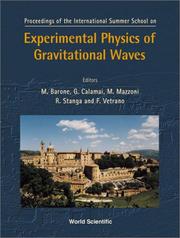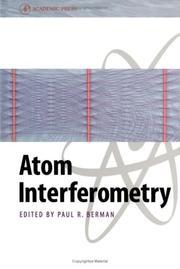| Listing 1 - 10 of 66 | << page >> |
Sort by
|
Book
ISBN: 2868836526 Year: 2003 Publisher: Les Ulis : Paris : EDP Sciences Agence spatiale européenne,
Abstract | Keywords | Export | Availability | Bookmark
 Loading...
Loading...Choose an application
- Reference Manager
- EndNote
- RefWorks (Direct export to RefWorks)

ISBN: 1281934178 9786611934170 9812792848 9789812792846 9810243065 9789810243067 9781281934178 6611934170 Year: 2000 Publisher: Singapore River Edge, N.J. World Scientific
Abstract | Keywords | Export | Availability | Bookmark
 Loading...
Loading...Choose an application
- Reference Manager
- EndNote
- RefWorks (Direct export to RefWorks)
This book introduces needed theoretical instruments and offers an up-to-date discussion on fundamental physics as well as the experimental tools used and developed for the construction and exploitation of gravitational wave antennae (resonant bars, ground-based and space interferometric detectors). In addition, problems in the fields of optics, signal processing, control and feedback in active mechanical filtering are deeply analyzed, with reference to recent solutions adopted in the main detectors.
Gravitational waves --- Interferometers --- Interferometer --- Optical instruments
Book
ISBN: 1000034458 3731500167 Year: 2013 Publisher: KIT Scientific Publishing
Abstract | Keywords | Export | Availability | Bookmark
 Loading...
Loading...Choose an application
- Reference Manager
- EndNote
- RefWorks (Direct export to RefWorks)
Für Objekte mit sehr ähnlichen Absorptionskoeffizienten, wie gesundes und karzinogenes Gewebe liefert der Absorptionskontrast häufig unzureichende Informationen. Eine vielversprechende Methode einer kontrastreichen Bildgebung bietet jedoch die Phasenkontrast Bildgebung in einem Talbot-Interferometer. Hierfür werden Gitter mit hohen Aspektverhältnissen benötigt. Im Rahmen dieses Buchs wird der LIGAProzess genutzt, um erstmalig Gitter mit einem Aspektverhältnis von mindestens 100 herzustellen.
Talbot-Interferometer --- LIGA --- Aspektverhältnis --- Phasenkontrast --- Röntgenoptik
Book
ISBN: 1000018509 3866445296 Year: 2010 Publisher: KIT Scientific Publishing
Abstract | Keywords | Export | Availability | Bookmark
 Loading...
Loading...Choose an application
- Reference Manager
- EndNote
- RefWorks (Direct export to RefWorks)
Die Modularisierung technischer Systeme bietet auf dem Gebiet der Mikrosystemtechnik im Bereich der Sensor- und Analysesysteme erhöhte Systemflexibilität bei sinkenden Herstell- und Entwicklungskosten. Die vorliegende Arbeit beschreibt die Entwicklung, Realisierung und Charakterisierung aktorbasierter mikrooptischer Systeme anhand eines adaptiven Mach-Zehnder Mikrointerferometers in modularer Bauweise. Als Basis dient die LIGA-Technologie in Kombination mit kommerziellen Systemkomponenten.
Mikrosystemtechnik --- Interferometer --- LIGA-Mikrosysteme --- Mikroaktorik --- modulare Mikrosysteme
Book
ISBN: 0198512554 Year: 1971 Publisher: Oxford : Clarendon press,
Abstract | Keywords | Export | Availability | Bookmark
 Loading...
Loading...Choose an application
- Reference Manager
- EndNote
- RefWorks (Direct export to RefWorks)
Interferometer --- Electromagnetic waves --- Ondes électromagnétiques --- Interferometers. --- Ondes électromagnétiques
Book
ISBN: 1000031463 3866449577 Year: 2013 Publisher: KIT Scientific Publishing
Abstract | Keywords | Export | Availability | Bookmark
 Loading...
Loading...Choose an application
- Reference Manager
- EndNote
- RefWorks (Direct export to RefWorks)
Self-coherent receivers are promising candidates for reception of 100 Gbit/s data rates in optical networks. Self-coherent receivers consist of multiple optical delay interferometers (DI) with high-speed photodiodes attached to the outputs. By DSP of the photo currents it becomes possible to receive coherently modulated optical signals. Especially promising for 100 Gbit/s networks is the PolMUX DQPSK format, the self-coherent reception of which is described in detail.
optical communications --- optics --- interferometer --- optical receiver --- self-coherent detection
Dissertation

Year: 2018 Publisher: Liège Université de Liège (ULiège)
Abstract | Keywords | Export | Availability | Bookmark
 Loading...
Loading...Choose an application
- Reference Manager
- EndNote
- RefWorks (Direct export to RefWorks)
The interferometry in space presents very big challenges for future observation, especially to image and characterize exoplanets. Space interferometry collects light with multiple mirrors. The light beams intercepted by these mirror are combined to create an interference patterns which can increase the resolution of the observed scene. This project has the objective to develop a deployable structure to place and hold mirror sub-pupils of a space interferometer at a distance (few meters) of the spacecraft. The challenge is to create a structure that provides stiffness and stability fitting with interferometry requirements in space.
Deployable booms --- Deployable structures --- Space interferometer baseline --- Astronomical interferometer --- Telescope --- Collapsible tube mast --- Collapsible boom --- Telescopic boom --- Articulated deployable boom --- Structures spatiales déployables --- Ingénierie, informatique & technologie > Ingénierie mécanique
Book
ISBN: 9290926457 9789290926450 Year: 2000 Volume: 451 Publisher: Noordwijk: ESA,
Abstract | Keywords | Export | Availability | Bookmark
 Loading...
Loading...Choose an application
- Reference Manager
- EndNote
- RefWorks (Direct export to RefWorks)
Astronomical spectroscopy --- Interferometers --- Space astronomy --- Instruments --- -Astronautics in astronomy --- Astronomy --- Space sciences --- Interferometer --- Optical instruments --- Spectroscopy, Astronomical --- Absorption spectra --- Astrophysics --- Spectrum analysis --- Darwin (Project) --- Infrared Space Interferometer Darwin (Project) --- Space Infrared Interferometer Project --- -Instruments --- -Interferometer --- Astronautics in astronomy --- Astronomical spectroscopy - Congresses. --- Interferometers - Congresses. --- Space astronomy - Instruments - Congresses.
Book
ISBN: 161499448X 9781614994480 1322211442 9781322211442 9781614994473 Year: 2014 Publisher: Amsterdam, Netherlands
Abstract | Keywords | Export | Availability | Bookmark
 Loading...
Loading...Choose an application
- Reference Manager
- EndNote
- RefWorks (Direct export to RefWorks)
Since atom interferometers were first realized about 20 years ago, atom interferometry has had many applications in basic and applied science, and has been used to measure gravity acceleration, rotations and fundamental physical quantities with unprecedented precision. Future applications range from tests of general relativity to the development of next-generation inertial navigation systems. This book presents the lectures and notes from the Enrico Fermi school ""Atom Interferometry"", held in Varenna, Italy, in July 2013. The aim of the school was to cover basic experimental and theoretical
Atom interferometry --- Interferometers --- Atoms --- Interferometry --- Chemistry, Physical and theoretical --- Matter --- Stereochemistry --- Interferometer --- Optical instruments --- Optical properties --- Constitution

ISBN: 0120924609 9786611036980 1281036986 008052768X 9780080527680 9781281036988 9780120924608 Year: 1997 Publisher: San Diego : Academic Press,
Abstract | Keywords | Export | Availability | Bookmark
 Loading...
Loading...Choose an application
- Reference Manager
- EndNote
- RefWorks (Direct export to RefWorks)
The field of atom interferometry has expanded rapidly in recent years, and todays research laboratories are using atom interferometers both as inertial sensors and for precision measurements. Many researchers also use atom interferometry as a means of researching fundamental questions in quantum mechanics.Atom Interferometry contains contributions from theoretical and experimental physicists at the forefront of this rapidly developing field. Editor Paul R. Berman includes an excellent balance of background material and recent experimental results,providing a general overview of atom
Interferometry. --- Interferometers. --- Atoms --- Interférométrie --- Interféromètres --- Optical properties. --- ELSEVIER-B EPUB-LIV-FT --- Chemistry, Physical and theoretical --- Matter --- Stereochemistry --- Interferometer --- Optical instruments --- Optical measurements --- Constitution
| Listing 1 - 10 of 66 | << page >> |
Sort by
|

 Search
Search Feedback
Feedback About UniCat
About UniCat  Help
Help News
News